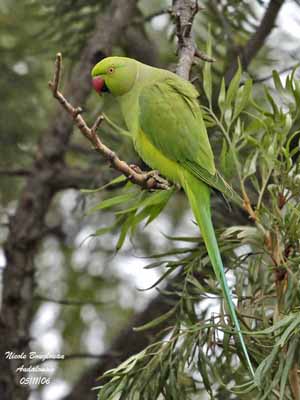
Parakeets, the little green invaders!
Monk Parakeet and Rose-ringed Parakeet now belong to our big cities. Often found in the large urban parks, they fly in noisy flocks, from tree to tree, as a superb green flash.
If the Monk Parakeet comes from South America and particularly from Argentina and the adjoining countries, on the other hand, the Rose-ringed Parakeet is native of the tropical areas of Africa and India.
Opportunist, they have adapted to the different habitats and climates. The human disturbances within the noisy cities do not trouble them! Introduced inhabitants of course, but well established in the large towns throughout many countries where important feral populations invade the green wooded areas. They represent among so many others, two of the best examples of the species’ adaptation to a new environment.
My interest for these birds started a few years ago, when a Rose-ringed Parakeet (Psittacula krameri) alighted into our garden, here, in SW France. What a great surprise! But our concern too… It was the winter. How this bird has arrived here? It was probably escaped from an aviary? Its owners were seeking it! So many thoughts crossed our mind in a few time, whereas the parakeet were quietly eating seeds on the bird-feeder. The other birds, suspicious, have dispersed into the nearby trees.
I tried to approach the bird while talking to it, but it moved away. It spent the night in the Cherry Laurel hedge, and finally, it has settled in the large neighbours’ park. It flew each day over our garden while calling. It seemed to be happy and in good health. It remained approximately three months, and then, it disappeared from the area. We never saw it again. It was a female. Perhaps with the breeding season approaching, she was searching for a mate? We will never know. But this Rose-ringed Parakeet allowed me to study this species and I finally understood that there was nothing to worry about her…

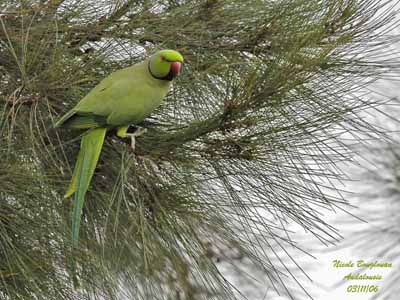
The female lacks the collar giving the bird its name. She has an indistinct emerald mark around the neck, but no more. The body shows a beautiful green plumage, slightly tinged with yellow and with blue-green wash on the tail.
On the other hand, the male has black and pink collar, with separates in elegant way the head from the body, covered with green plumage slightly tinged with yellow or darker green. The black eye sparkles with curiosity, surrounded by pink eye-ring. The hooked bill is bright pink, giving the bird a comical look quite relational with its player and mischievous spirit.
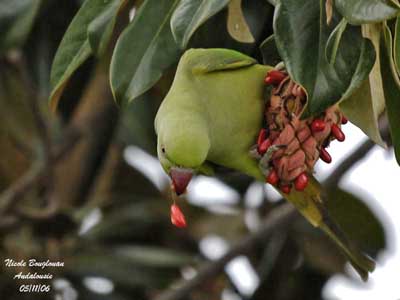
The Rose-ringed Parakeet feeds on fruits, seeds and varied flowers. It peels the seeds, softly removing the shell around the smooth parts. On the close picture, it feeds on magnolias’ seeds, and drops the red skin to the ground, in order to consume the heart. It feeds hanged to the fruit, sometimes upside down, performing several acrobatics for satisfying its hunger and mainly its greediness.
In some countries where it lives, large congregations at food sources such as cultivated areas which are quickly devastated by these large flocks, make it an important crop-pest.
I saw for the first time the Monk parakeet (Myiopsitta monachus) in Tenerife (Canary Islands - Spain). These birds live here all year round in gregarious flocks, flying from tree to tree in noisy groups, and crossing the blue sky in the same rapid wing beat.
These parakeets feed on seeds, buds and fruits. When I saw them, they were nibbling palm fruits while squabbling. These birds move into the trees thanks to their claws and bill, grabbing to the branches and the stiff leaves, in order to climb or to move laterally.
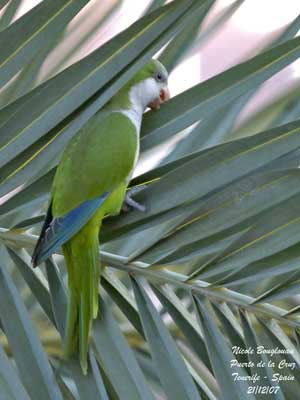
The toes are also used for feeding. The parakeets hold the fruit with one foot and bring it to the bill, in order to feed it easily when it is come off the weed. The strong bill allows them to break a pine cone yet opened for getting the seeds.
In Monk Parakeet, male and female are similar, showing green plumage, dark blue flight feathers and grey crown, white chest streaked with grey and greenish-white belly. On the beautiful head, we can see the horn-coloured bill, whereas the dark eyes are eloquent about its determination for feeding and defending its territory! Stockier than the Rose-ringed Parakeet, it is smaller and its tail is shorter.
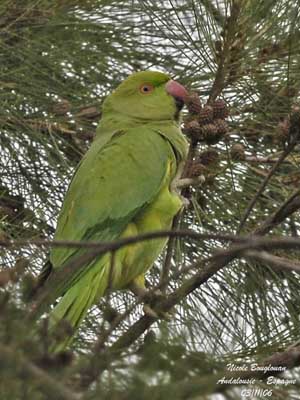
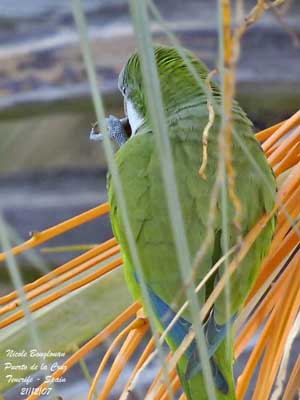
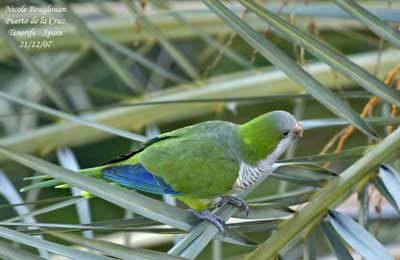
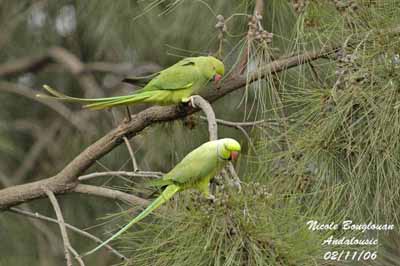
These two birds of the Psittacidae family nest quite differently. The Rose-ringed Parakeet nests in natural cavity, a hole in tree or an old woodpecker hole. If necessary, it enlarges the entrance by chewing the wood around the hole. The resulting dusk and debris are used for lining the cavity’s bottom where the eggs will be laid. But it also can shelter the clutch in a crevice in walls or under a roof. They nest solitary or sometimes in loose colonies, and the pair is monogamous.
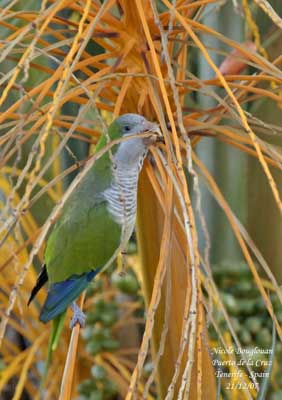
The Monk Parakeet nests alone or in colonies, but it builds a nest, whereas the other Psittacidae prefer cavities. The nest is placed in the high branches of a tree, or on high structure. The nest is made with twigs, often thorny twigs, in order to protect it against the predators. It may include only one chamber or much more if it is a colony. These large structures are maintained all year round by all members of the group. Some nests can weight more than a tonne. In addition, these nests are used as night-time roosts that explain the permanent maintenance.
I observed the Monk Parakeets feeding in a palm-tree, but before to go away, each one cut a twig with the bill in order to add it to the nest.
In both species, incubation lasts about three weeks, and the nesting period varies from six to seven weeks.
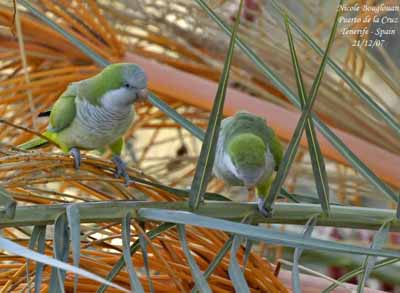
The Monk Parakeet is native from Brazil and Argentina. It has been introduced into United States as pet, and escaped birds have proliferated throughout the country. Introduced into Europe, Israel, Japan, Bermudas, Puerto Rico and Canary Islands, the species has adapted very well to these different environments. After living in natural and wide areas, they colonised numerous large cities, first in urban parks, before to establish definitively in wooded areas around the towns, and mainly in cultivated areas and orchards where they damage the crops. Their calls and shrills, and also the unceasing chattering of the colony make them noisy, and even being very nice, it is really disturbing.
The Rose-ringed Parakeet comes from the tropical areas of Africa and India. It has been introduced into Middle East and Far East, and into United States, England, the Netherlands, Belgium, Germany, Spain and Italy. It also has arrived to France and seems to be very fine here! As the Monk Parakeet, it forgot its native territories, the semi-desert areas and the forests where it was born, for enjoying the cultivated fields where they feed in devastating flocks, the urban parks, the orchards and the large overpopulated cities. They give shrills when they are flying or perched in trees, and raucous or high-pitched notes if they are threatened. They chatter continuously at the colony. We cannot miss her! Their noisy presence may soften or disturb, but their beauty and liveliness make them captivating birds which animate the urban parks thanks to their beautiful presence.
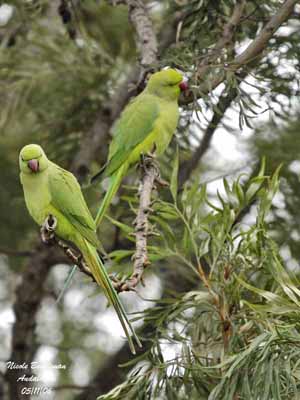
Parakeets, like other Psittacidae, are captivating birds. They are very smart, able to adapt and survive in hard conditions. Illegal pet-trade, deforestation, persecutions and disturbances are harmful to them, but however, they gather in colonies, in order to get more security by the numbers, and they are opportunist enough to survive. But they cannot do anything against the habitat loss, and several species disappear little by little.
But fortunately, our little green invaders are not threatened and breed fairly successfully in their country of adoption. These birds are very strong, and outside Polar Regions and deserts, these Psittacidae are able to live in a wide variety of habitats. And after all, they often add a little exotic note in our austere cities! So, let’s enjoy their coloured presence, even if their calls are sometimes too much loud for our ears! It is really more pleasant than the traffic noises or the telephone ringing! We only have to close the eyes and imagine we are walking into the forest, surrounded by bright coloured birds… it is that we name a thought’s escape!
Text and pictures by Nicole Bouglouan
Sources:
HANDBOOK OF THE BIRDS OF THE WORLD volume 4 by Josep del Hoyo, Andrew Elliot and Jordi Sargatal – LYNX EDICION – ISBN 8487334229
PARROTS OF THE WORLD – An Identification Guide – by Joseph M. Forshaw – Princeton University Press – ISBN 0691092516